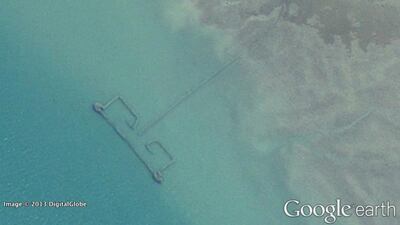Scientific research is often about being meticulous and patient, but few researchers have ever faced a task quite as painstaking as the one Dalal al Abdulrazzak had to contend with.
A postgraduate student at the University of British Columbia in Canada, Ms al Abdulrazzak spent three months full-time carefully looking through Google Earth satellite images of the Arabian Gulf coastline.
With her eyes glued to her computer screen, the Kuwaiti researcher was trying to identify fishing weirs, large structures in tidal areas that, from above, can look a little like piers that curve round at the end.
Analysing the images, she found plenty of weirs. So many, in fact, that it appears official data on total fish catches in the Arabian Gulf could be significantly underestimating the actual catch, with potential ecological implications.
Ms al Abdulrazzak conceived the idea of using Google Earth to calculate fishing catches by “complete fluke” while trying to locate her family home using the service.
“I remembered as a child there was a weir in front of the house. [Looking at] where the house was, I realised you could see them from space,” she said.
She counted 1,656 weirs off the coasts of the UAE, Kuwait, Saudi Arabia, Qatar, Iran and Bahrain.
There are very likely to be more; some weirs will have been obscured by cloud on the day the Google snapshot was taken, or not visible because of poor resolution. Ms al Abdulrazzak reckons the real total is more like 1,900.
Using data for average daily catches, the authors calculated that each year in the Gulf, around 31,400 tonnes of fish are caught using weirs.
Yet official figures for the Gulf reported to the Food and Agriculture Organisation of the United Nations indicate a total weir harvest of just 5,260 tonnes.
Why such a big discrepancy? It’s not surprising that there should be one, says Ms al Abdulrazzak – countries around the world, not just in the Gulf, tend to under-report fish catches. But the magnitude of the difference was larger than expected.
In the case of the UAE, where there are about 95 weirs, mostly off the coast of Abu Dhabi emirate, the estimated catch of just under 1,300 tonnes compares to a reported figure of 600 tonnes.
Other nations showed an even greater disparity. Bahrain’s estimated catch of 17,125 tonnes dwarfs the official figure of 1,960 tonnes. The island kingdom is believed to have about 880 fishing weirs.
Innovative – and time consuming – though the weir-counting method was, on its first publication in late 2013 in the ICES Journal of Marine Science, it generated heated debate.
One paper suggested the researchers had overestimated actual catches and that some of the weirs counted were actually inactive. The critics also argued that the authors had overestimated how many weirs had been missed out due to poor resolution in the original images.
These arguments didn’t hold much water. Ms al Abdulrazzak and her PhD supervisor, Professor Daniel Pauly, noted, for example, that when Google did get round to covering previously low-resolution areas in higher resolution, the new images tended to show that there were actually more weirs present than their estimates suggested.
Setting aside the controversy, few would take issue with the view that official figures underestimate the amount of fish caught using weirs. And that discrepancy has ecological implications.
When top predators are removed what is called a “trophic cascade effect” can result, with consequences further down the food chain.
“If you remove the predator, the prey will probably increase and whatever these prey are preying on will probably decrease,” said Ms al Abdulrazzak.
“Studies on coral reefs have shown if you remove enough of the fish, the algae will over grow and smother the coral. That’s an example of what could happen in the Gulf, if it hasn’t already happened.”
Overfishing could ultimately represent a threat to the Gulf’s food security, as fish are the region’s second most important natural resource after oil.
Overfishing is already hitting catches in several Gulf countries, said Prof Pauly. And some of these countries also discard much of their catch because there isn’t a local market for certain types of fish.
But solutions aren’t easy to find in such multinational waters.
“A lot of the fishing stocks are held between many countries,” said Ms al Abdulrazzak. “Any regulation would have to be co-ordinated regionally. It’s very difficult due to the politics in the area.
Having proper data is, she said, the first step towards improving the regulation of fishing, and ensuring stocks are not over-harvested.
Just as the UBC researchers have used Google satellite images, so conservation groups are beginning to make use of similar pictures to track illegal fishing around the globe.
Thanks to work funded by Google and spearheaded by the pressure group Oceana, campaigners can now track the movements of individual vessels around the globe using GPS data.
Prof Pauly, who has led a major project to document fishing catches worldwide, described this new technique as “fantastic”.
“You can see vessels in the middle of nowhere, where they shouldn’t be, so it’s ideal,” he said.
Back in the Gulf, he and Ms al Abdulrazzak are next year planning to publish estimates for total fishing catches in the Gulf by all methods, not just weirs.
This work, which has included analysis of documentary evidence not used when the various countries compile their official figures, indicates that actual catches from all fishing methods are significantly greater than official data suggests.
With this sort of research at their fingertips, policymakers should in future have the accurate data they need to make informed decisions about what can – and cannot – be removed from the Arabian Gulf.
newsdesk@thenational.ae


